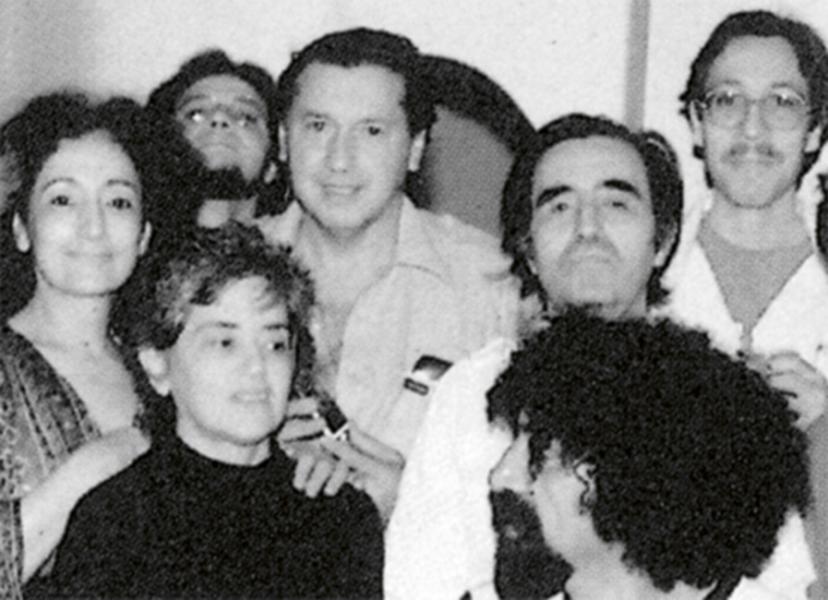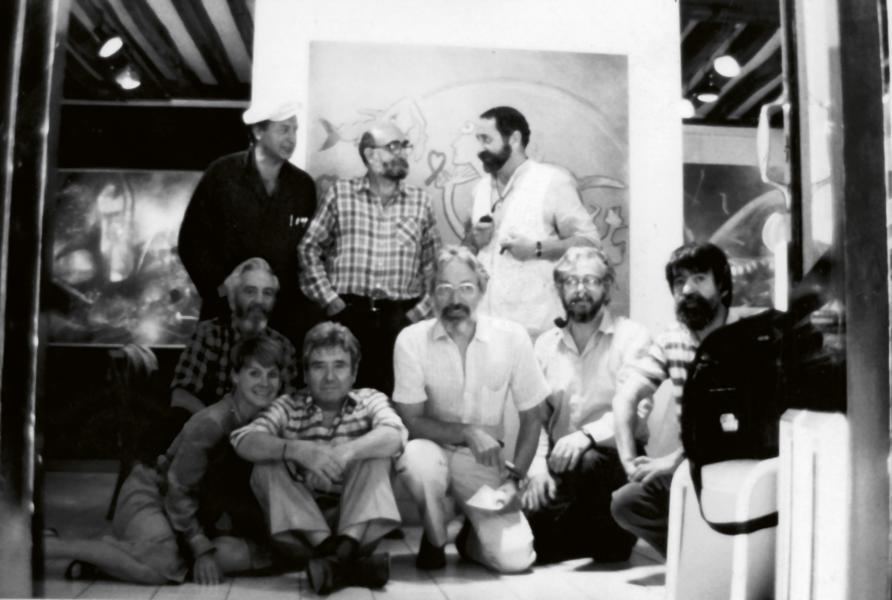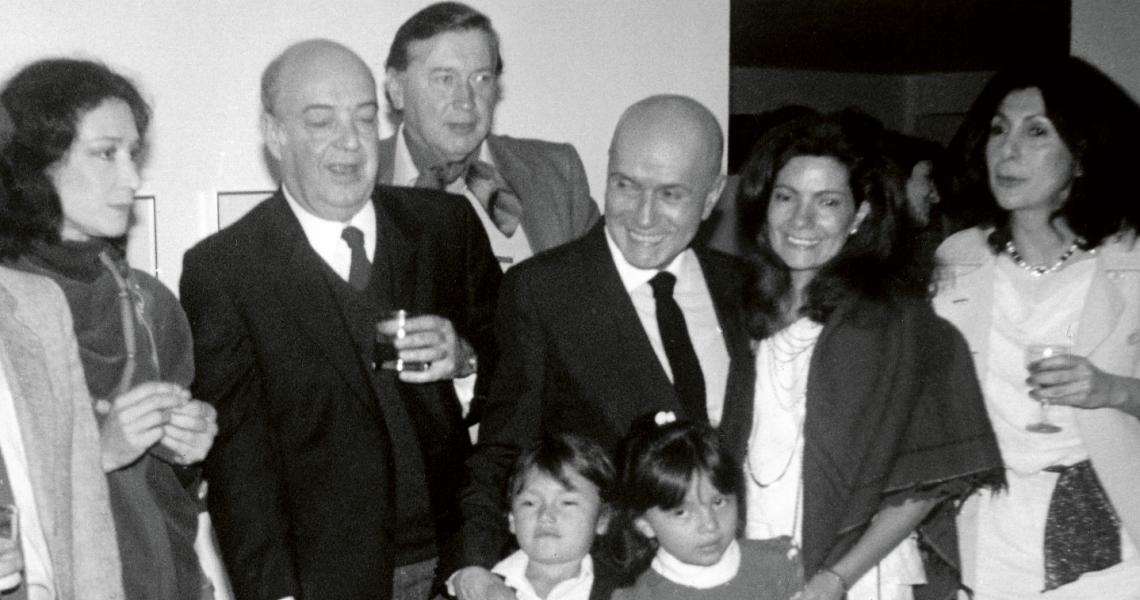1979
Le Parc took part in the Latin American and Caribbean Arts Encounter in the Casa de las Américas in Havana. A re-encounter with Cuba, its socioeconomic and political situation and its place in the world, and with the evolution of the issue of the plastic arts on the island. Positive exchanges. In Cuba, Le Parc offered a series of ideas about the creation, validation and appreciation, and sale of Cuban art and about its direct confrontation with the society and its people.
Le Parc took part, with his audio-visual La otra faz del arte, el artista y su contexto social (The Artist’s Other Face : The Artist and His Social Context), in a series of meetings with young Spanish artists in Montesquieu.
Le Parc had a series of solo exhibits in Venezuela and one in Peru, accompanied by conferences, encounters with artists and art students at roundtables, and exchanges based on Le Parc’s audio-visual. Development of themes around the series Modulations, freer and reincorporating color. Reestablishing contact with Italy: encounters, trips, and exhibits.
 Avec Malvina et Raphael Lemor, Lima, 1979
Avec Malvina et Raphael Lemor, Lima, 1979  Avec Martha, Marcelo, Agostini et les Foretas, San Marino di Lupari, 1979
Avec Martha, Marcelo, Agostini et les Foretas, San Marino di Lupari, 1979 1980
In Rome, Le Parc took part in Setta Latino-Americana : encounter and exchange with Latin American artists, poets, writers, musicians, and filmmakers. In Macerata, Italy, Elverio Maurizi published a book on Le Parc, Modulazione della Luce, on the occasion of a solo exhibit. Debates organized around the exhibit. Le Parc does an intervention at the School of Architecture in Nantes.
In Paris, Le Parc and a group of Latin American writers, musicians, artists, and intellectuals created the Association for Latin American Culture.
In Sofia, Bulgaria, Le Parc took part in a symposium on Latin American culture organized with the collaboration of the Casa de las Américas in Havana : encounter and exchange with Bulgarian artists, architects, and writers, with a re-encounter and new relations with the other Latin American participants.
In Paris, with Latin American artists José Gamarra, Alberto Guzmán, Rodolfo Krasno, Fernando Maza, Gontran Netto, Luis Felipe Noé, Leopoldo Novoa, Arthur Luiz Piza, Juvenal Ravelo, Luis Tomasello, and Jack Vanarsky, Le Parc organized a project to create a Latin American cultural space, which was inaugurated in December. The objective of this space was, within its power, to promote and publicize Latin American culture.
Le Parc developed new themes for the series Modulations, accentuating the presence of light.
 Avec Martha, Spoleto, 1980
Avec Martha, Spoleto, 1980 1981
Preparations for Le Parc’s major retrospective exhibition at the Museo de Bellas Artes, Caracas. Le Parc developed new themes around the experiences of light and games ; he also further developed ideas for his most recent canvases, in which the representation of light, the presence of light, became preponderant. With architect and painter Carrossino, Le Parc formed a team to present a project at the World Architecture Biennale, to be held in Sofia. The biennale’s theme was “The Architecture of Urbanized Societies.” This project, based on several spatial interventions, sought a new social behavior in which the participation, interrelation, communication, and creativity of people would be stimulated through collective reflection and action.
Le Parc’s retrospective in Caracas consisted of over 200 works and created an expansive yet direct relationship with the public. On this trip, Le Parc reestablished contacts in Venezuela, Colombia, and New York.
A historic exhibition of works by GRAV in Macerata, Italy.
Le Parc and some 300 other delegates took part in the Encounter of Intellectuals in Support of the Sovereignty of the Peoples of the Americas, held in September in Havana. Le Parc presented a paper titled “Valuation: Key Weapon for Cultural Penetration.”
Le Parc also took part in the symposium Art and Latin American Identity, organized by the Contemporary Art Forum, Mexico City, with a text in response to a paper by critic Juan Acha. New contacts with Mexican art. On this occasion, a collective mural on the same theme was created by the Brigade of Anti-Fascist Painters, with which the ACAL members took part in a street demonstration in Paris.
Another trip to Cuba, and contacts, for a solo exhibit at the Casa de las Américas as part of the Havana Exposition, which traveled then to Managua, to which Le Parc had been invited by Sergio Ramírez. Contacts with the Sandinista Revolution; ideas and exchanges with Nicaraguan artists.
Several trips to Italy: exhibits and new relations with Italian artists.
 Avec Laura Marquez, Juan Carrera, Sergio Moyano, New York, 1981
Avec Laura Marquez, Juan Carrera, Sergio Moyano, New York, 1981  Espace latino-américain ; Tomasello, Le Parc, Noé, Piza, Krasno, Mme Matta, Matta, Novoa, Netto, Paris, 1981
Espace latino-américain ; Tomasello, Le Parc, Noé, Piza, Krasno, Mme Matta, Matta, Novoa, Netto, Paris, 1981  Avec Daniel Ortega, le père Cardenal, Sergio Ramírez et Martha, Managua, 1981
Avec Daniel Ortega, le père Cardenal, Sergio Ramírez et Martha, Managua, 1981 1982
Le Parc and a group of Latin American artists began making official arrangements in the French Ministry of Culture for an important exhibition of Latin American art, one that would provide a fairer image of Latin America, to be held at the Centre Georges Pompidou.
Le Parc lent his support to an important exhibit of Latin American artists working in Europe, to be held in the Venice Museum of Modern Art. On this occasion, Le Parc was invited to take part in a colloquium, for which he responded in writing to a series of questions.
Not without problems, the Espace Latino-Americaine, which Le Parc had fostered and was part of, continued working at its venue in Paris to make Latin American art better known; after the death of Rodolfo Krasno, the space’s driving force, Le Parc took an active role in a restructuring of the organization that allowed the space to continue its work.
“Droits Socialists de l’Homme” called upon a group of artists, among them Le Parc, to help with the mounting of an enormous exhibit by Latin American artists in Paris, to be held at the Grand Palais. This exhibit made clear the vibrant creativity of the Latin American artist community in Paris and made possible this group’s greater international recognition.
Le Parc became a member of the Committee of Artists of the World against Apartheid in South Africa.
1983
Le Parc was invited to take part in the symposium Création et développement (Creation and Development) organized by the French Ministry of Culture at the Sorbonne. This symposium was extraordinarily important due to the number and quality of its participants (400 internationally recognized participants from around the world and all artistic and intellectual disciplines), the worldwide crisis of the moment, the issues addressed, and the exchanges at a personal level that took place. At this congress, the Latin American group made a strong statement on the existence of Latin American culture, the vision of that culture the world should have, and the need for a reassessment that would accord the region its rightful place in world culture. Le Parc’s participation centered on the problem of valuation. In the Espace Latin-Americain, Le Parc mounted an exhibit titled Chaîne, whose objective was to explore new systems of selection and mutual respect between artists.
Le Parc refused to take part in the exhibit Electra in the Musée d’Art moderne de la Ville de Paris, and in a text denounced the incongruousness of the organizers. On the occasion of a solo exhibit in Madrid, Le Parc produced a text titled “Some Reflections on My Current Work.”
Creation of a 1,600-square-foot mural for the city of Fuengirola, Spain.
Le Parc contributed to the open-air sculpture park in Medellín, Colombia, with two monumental works.
From Jack Lang, French Minister of Culture, Le Parc received the title Officier de l’Ordre des Arts et des Lettres.
 Avec Alberto Biasi, 1983
Avec Alberto Biasi, 1983  Avec Martha, Sergio Camargo et Edgar Negret, Bogotá, 1983
Avec Martha, Sergio Camargo et Edgar Negret, Bogotá, 1983 1984
A stay in Cuba for the 20th anniversary of the Casa de las Américas. Le Parc served on the jury for the first Havana Biennial. Proposals, discussions, new contacts within Cuban cultural circles. Creation of two serigraphs.
Trip to Buenos Aires, after 11 years of absence, for a solo exhibit. Re-encounter with a country living through the nightmare of a military dictatorship. Exchanges, public discussions, new contacts. On his return from that trip, Le Parc sent the cultural officials of Argentina a proposal concerning the arts.
Trip to Colombia for a series of exhibitions and for a “pedestrian” work in the Omar Rayo Museum for the city of Palmira. In Roldanillo, Le Parc took part, with other painters, in an experience in the street with the public. In Medellín, for the sculpture park, Le Parc created two works and proposed a project of surveys to be made of the visitors.
In Lima, Peru, a showing of the audio-visual Ser artista hoy (Being an Artist Today) and a roundtable on the subject.
 Avec Omar Rayo, Roldanillo, 1984
Avec Omar Rayo, Roldanillo, 1984  Avec Astor Piazzolla, Buenos Aires, 1984
Avec Astor Piazzolla, Buenos Aires, 1984 1985
First trip to Ecuador, on the occasion of a solo exhibit. Encounter with the Ecuadorian art world through private and public conversations.
Le Parc took part in a portfolio of prints on the universal declaration of human rights, in homage to Fray Bartolomé de las Casas. The portfolio was presented to the King of Spain, in Madrid. In Carboneras, Almería, Andalucía, in Spain, Le Parc set up a studio and took part in a workshop to initiate interested parties into the arts. Creation of editions using pochoirs in a print workshop set up in Cachan, France, by his sons Juancito and Gabriel.
In the Círculo de Bellas Arts in Madrid, Le Parc led a workshop on contemporary art, and he and the participants in that workshop created a collective “intervention” in the Parque del Retiro.
Le Parc prepared a survey of his work for the galleries of the Valencia government center, in Spain.
In Havana, under the auspices of the Casa de las Américas, Le Parc took part in the second Congress of Intellectuals in Support of the Sovereignty of the Americas. On that occasion, he presented a proposition for an “Open Council of the Arts.”
Attended the Dialogue of the Americas, which was organized in New York City: an exchange of ideas on political, economic, and cultural issues by Latin and North American creators and intellectuals.
 Avec Silvano Lara et Wilfredo Lam, La Havane, 1985
Avec Silvano Lara et Wilfredo Lam, La Havane, 1985  Avec Mariano Rodríguez et Netto, La Havane, 1985
Avec Mariano Rodríguez et Netto, La Havane, 1985  Avec Mariano et un groupe d’artistes latino- américains, La Havane, 1985
Avec Mariano et un groupe d’artistes latino- américains, La Havane, 1985  Avec Camnitzer, La Havane, 1985
Avec Camnitzer, La Havane, 1985  IIe rencontre des intellectuels pour la souveraineté de notre Amérique, La Havane, 1985
IIe rencontre des intellectuels pour la souveraineté de notre Amérique, La Havane, 1985 1986
The Círculo de Bellas Artes of Madrid commissioned Le Parc to design its traditional, and very prestigious Masked Ball. This gave rise to intense collective work in which those who had attended the contemporary-art workshop took part. The entire building was occupied by art installations, creating a vivid experience that piqued the imagination of all those who attended the ball. The result was a participatory celebration in a brilliantly creative setting.
Le Parc continued his personal work on the Modulations series. For the exhibit Giovani e Maestri in Rome, he created a very large-scale work in four parts; two other similar works were created for simultaneous exhibits in the Rayuela and Juan Gris galleries in Madrid.
After visiting the exhibit Contraste de forma in Madrid, Le Parc reacted to the arbitrariness of the exhibit with a text published in Diario 16.
Took part in the Venice Biennale; yet another encounter with the artistic circles of that city.
On the occasion of the production of a short film, Le Parc mounted a “demonstration” in his studio titled Portes ouvertes (Open Doors), which included, in addition to a retrospective of his work, works by other members of his family and by young artists associated with his studio.
Invited to the second Havana Biennial. For one month Le Parc led a workshop in that city for young Cuban creators. This became an intense activity and led to a full day of collective experiences in one of the city’s plazas, and in close contact with a large audience “from the street.” This activity led Le Parc to produce a text reflecting on the Biennial in general and that experience in particular.
1987
Taking part in the first Biennial of the Art of the Americas in Cuenca, Ecuador, Le Parc was awarded the Grand Prize. He donated half of the prize money to the Nicaraguan people (to be administered by the Nicaraguan vice president, writer Sergio Ramírez) and half to be given as two prizes at the second Cuenca Biennial: one to a young Ecuadorian artist and one to a young Latin American artist.
For various artistic activities, Le Parc traveled to several Latin American cities—Quito, Cuenca, Bogotá, Medellín, Panama City, Santiago de Chile, and Mendoza and Buenos Aires in Argentina—renewing his ties to Latin American creators and experiencing at close range the particular situations of those countries, especially at the level of art, with meetings, chats, public discussions, etc.
Continuing his participation in the Espace Latin-Americain in Paris, Le Parc helped expand that association by incorporating young artists.
At the end of the year, his first grandchild, a little girl, Luna Luz, was born to Juancito and his wife Elisabeth (Eli).